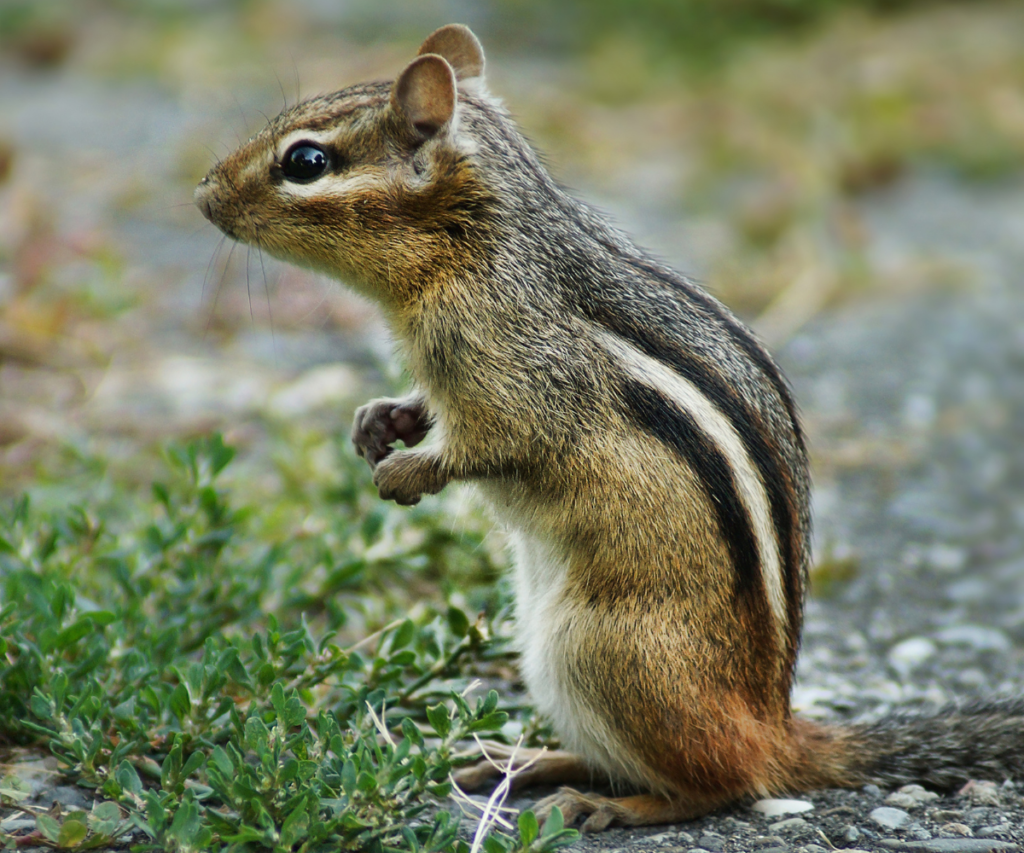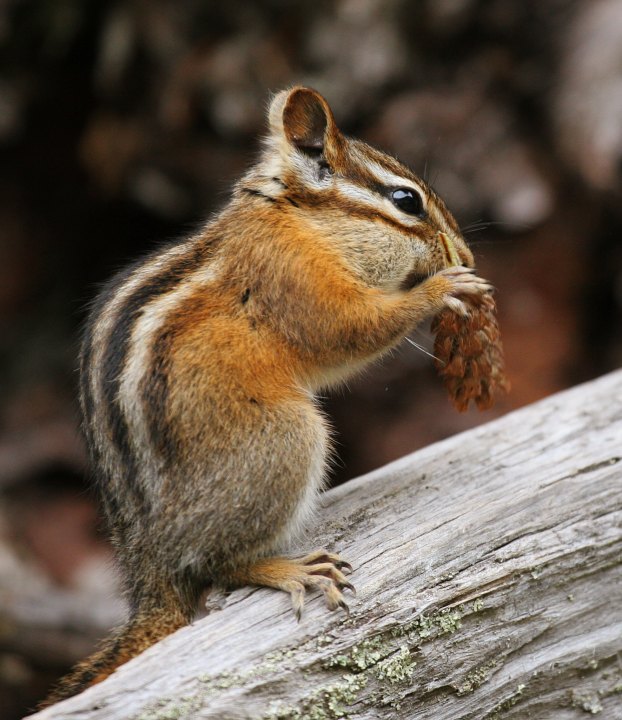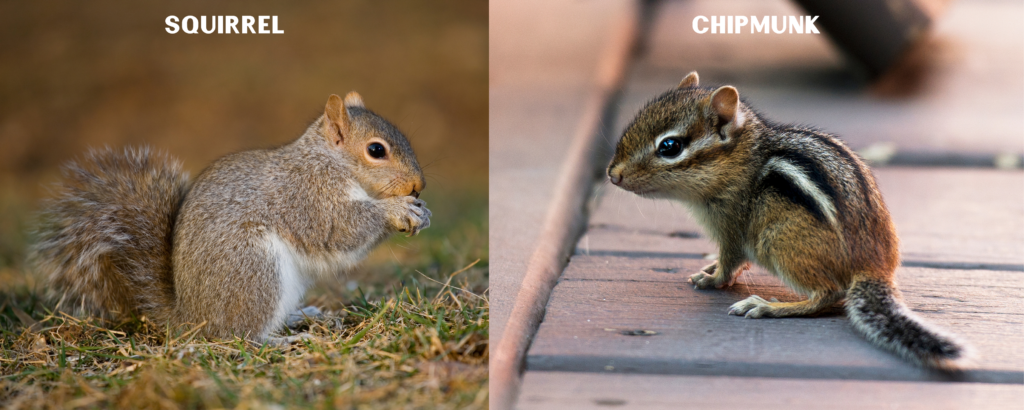Chipmunks are cute and adorable, but the damage they cause isn’t.
If you’re tired of dealing with chipmunks in your garden and around your home, then you’re in the right place.
In this post, I will go over seven different ways you can use to get rid of chipmunks.
Lets’s dive in.
How To Identify a Chipmunk?
There are over twenty species of chipmunks in the United States.
The two most common species of chipmunks that commonly inhabit near structures are the Eastern Chipmunk and the Least Chipmunk.
Eastern Chipmunk

The Eastern Chipmunk the most popular chipmunk found in the northeastern parts of the United States.
There are a few distinct characteristics of the Eastern Chipmunk:
- Reddish-brown fur around the body.
- Four Black and Two white stripes on the back
- Whitecoat of fur on the stomach
- Long, furry tail
- Dark facial marking on under and around the eyes
- Pouches in the cheeks for storing food
- Large, rounded ears
Least Chipmunk

The least chipmunk is the smallest and most popular chipmunk in North America.
There are a few distinct characteristics of the Western Chipmunk:
- reddish-brown fur
- Greyish white fur on their underparts
- Only 6.2 inches
- Long, narrow, and fluffy tail
- The only weight 2oz or less
- Black stripes on either side of the face
- Four black stripes along the back of their body
- They tend to get lighter or reddish during the summer months and greyish during the winter months
Chipmunks vs. Squirrels

Chipmunks are a species of ground squirrel.
The squirrels most people are familiar with are tree squirrels.
You can tell the difference between chipmunks and squirrels by their size and stripes.
Chipmunks are significantly smaller than squirrels. They are distinct because they have stripes on their body and head.
Squirrels are also known for their large, fluffy tails. On the other hand, chipmunk tails are generally shorter, narrower, and less fluffy.
How To Get Rid of Chipmunks?
1. Use Traps
Using traps is one of the most effective ways of getting rid of chipmunks around your home.
Since chipmunks are small, you can use the same traps you would use for rats or squirrels. There are two types of traps you can use on chipmunks:
- Live traps
- Snap Traps
Sometimes your choice of chipmunk trap is not up to you. In certain states, it’s illegal to kill or use snap traps on chipmunks. Before you buy your chipmunk traps, check the laws and regulations where you live.
Live Traps
Live traps are the most humane way of getting rid of chipmunks. These traps catch and keep chipmunks alive.
These traps have one entrance. At the center of the trap, there is a trip mechanism.
When the chipmunks walk over the trip mechanism, the entrance will close and trap the chipmunk inside.
The most effective way to get a chipmunk inside a trap is to use bait. The effectiveness of your trap is highly dependent on the bait you use.
This is why you must use a bait that chipmunks are attracted to.
Here are some of the most effective chipmunk baits you can use:
- Peanut butter
- Corn
- Prunes
- Cereal
- Gains
- Popcorn
- Cheese
- Unroasted peanuts
- Sunflower seeds
If you find that the chipmunks aren’t entering the traps, you might want to consider using a different bait.
When placing your bait, place a small piece of bait at the entrance. This will entice them to approach the trap.
You also need to add some bait, just beyond or on the trip mechanism. When the chipmunk enters to eat the bait, it will activate the trip mechanism and trap the chipmunk inside.
Remember to check your traps every one to two days for activity.
Snap Traps
Snap traps are deadly traps that will kill chipmunks. In some states, killing chipmunks is illegal.
Before you begin using snap traps to remove chipmunks, make sure they are legal where you live.
Snap traps are simple. When a chipmunk walks over the trigger, the trap will snap on the chipmunk. The trap will deliver an instant kill.
Similar to live traps, you must use an effective bait to attract chipmunks. You can use the same bait you would use on a live trap.
Snap traps are dangerous. You must keep children and pets away from snap traps. Either keep children out of your yard or create a border to keep them safe.
Homemade Chipmunk Traps
Using homemade chipmunk traps are a common solution to catching and getting rid of chipmunks. One of the most popular homemade traps is the bucket trap.
This trap is easy and cheap to make.
what you need:
- Large Bucket
- 3′ – 4′ piece of wood
- Sunflower seeds
- Peanut Butter
Once you have everything you need, you can start by filling up your bucket 3/4 with water.
Then apply a thick layer of sunflower seeds to the top of the water. This will act as the bait. You can add a layer of peanut butter along the rim, right above the waterline, for some additional encouragement.
The chipmunks will try to get the food and will fall into the bucket trapping them. Over time, they will drown and die.
2. Clean your Yard
One of the first steps to getting rid of chipmunks is to make your home as unappealing as possible.
While cleaning and maintaining your yard is more of preventative measures is also an effective elimination method.
If your yard does not have any food or water sources, chipmunks will look for other areas that have what they need to survive.
Chipmunks can only survive two to three days if they don’t have food or water.
This means if you can maintain your home for several days, you can make a huge difference.
The best thing you can do is to eliminate food and water sources.
Below are some tips you can take to make your yard less appealing to chipmunks
- Eliminate standing water
- Replace bird feeders with squirrel and chipmunk resistant feeders
- Clean and remove fruits and vegetables that drop to the ground
- Trim vegetation and remove any wood or vegetation from the ground. Chipmunks can use this to start
- Seal your home for any cracks and crevices where chipmunks could burrow
- Cover flowers or gardens with netting
- Secure trash cans
Taking simple steps to make your home less appealing can go a long way to driving chipmunks away from home.
3. Use Repellents
There is often a misconception that chipmunks tend to live in trees. The reality is that chipmunks create tunnel systems underground.
This is what makes rodent repellents effective against chipmunks. If you know where their nests is located, you can make the repellent even more effective.
Even without knowing their nest location, you can apply repellent to your yard and anywhere near trees or other areas that may attract chipmunks.
You can use two different types of repellents to get rid of chipmunks: natural or chemical repellents.
Natural Repellents
One of the most common sources of repellents is using spicy foods that contain capsaicin. Capsaicin is said to repel most rodents, including chipmunks.
You can use cayenne pepper and spread it over your garden or around your yard to keep chipmunks away.
Other common natural repellents that you can use is
- Peppermint essential oil
- Apple cider vinegar spray
- Garlic and vinegar spray
Remember that these repellent options typically require much more frequent reapplication compared to chemical repellents.
Chemical Repellents
There are not many chemical repellents specifically made for chipmunks. But, chemical repellents for rodents such as squirrels or gophers are also effective against chipmunks.
Chemical repellents can come in two different forms: liquid or granules.
When using liquid repellents, I recommend using a pressurized sprayer.
This will make it easy to apply repellents around your yard and home.
Some chemical repellents are applied using granules. Granules are small pellets that can be spread across your yard. Water is then applied to the surface to activate the repellent.
While chemical repellents last longer than natural repellents, they still need frequent reapplication. In most cases, chemical repellents will only last between one week and several weeks, depending on the weather.
Typically harsh weather conditions can cause the repellent to wear off sooner than one week.
5. Use Poison
Before using poison on chipmunks, you must make sure it’s legal to kill chipmunks where you live. In certain states, killing chipmunks may be illegal or require a license.
When using poison on chipmunks, you can use the same poison used on rats and squirrels. When using bait on chipmunks, it’s best to use bait stations.
Bait station will protect the bait from the elements and also only allow smaller animals to eat the bait. If there are other animals around your yard, such as raccoons or dogs, they won’t have access to the poison.
There are two types of poison you can use: slow-acting and fast-acting.
Types of Poison
Slow acting bait is popular and effective because the rodents can spread it to other members. These baits require multiple feedings and can take up to seven days to take effect.
Fast-acting poison typically takes effect within 24 hours.
Disadvantages
Before you begin using poison to get rid of Chipmunks, there are a few disadvantages.
First, chipmunks don’t always eat bait immediately. They can store it for later, and this means they won’t die until they eat it.
Another downside is that chipmunks may not always find the food appealing or attractive, especially if other food sources are present.
When using poison, clean the area around your home. Eliminate any potential food sources. This will make the poison more attractive to chipmunks and encourage them to eat it.
It’s also ideal to position your bait where chipmunks frequent. This will make it more likely that they encounter and eat the bait.
6. Use Deterrents
One common way that you can deter chipmunks is by creating barriers around your garden. You can also use bulb cages to protect potential fruit or vegetable plants from chipmunks.
You can use barriers to prevent chipmunks from gaining access to potential food or water sources.
Motion Activated Sprinklers
You can also use motion activated sprinklers around your home to discourage chipmunks from entering your yard.
Using sprinklers is a natural alternative that will prevent chipmunks from damaging your garden and home.
While this method effectively protects your garden, it’s not always a long-term solution to getting rid of chipmunks.
The sprinkler will provide chipmunks with the water to survive. With a steady supply of water, chipmunks will have no incentive to leave and only look for another food source.
Decoys
Another common way to deter chipmunks is by using a decoy. Decoys are small statutes or motion activates models. These are most effective if they are shaped like a chipmunk predator.
Some of the most common decoys you can find are owls and hawks. These are great deterrents because, naturally, chipmunks will avoid their predators.
7. Introduce Predators
Another natural way of getting rid of chipmunks is by introducing natural chipmunk predators to the area.
Natural predators will help remove chipmunks naturally and could also prompt chipmunks to nest somewhere else.
Many chipmunk predators cause much of the same damage to your gardens and homes.
For example, you could introduce raccoons or snakes to your yard, but they are not a much better alternative to chipmunks.
Birds such as hawks and owls are some of the best predators to introduce near your home without damaging your garden and imposing additional dangers.
Other great predators you can introduce are weasels or ferrets. These animals have a fast metabolism, which requires them to eat often. They are also small and fast, making hunting and catching chipmunks easy.
If you are aware of the chipmunk nests’ location, you can also release corn snakes into your yard and nests.
These are non-venomous snakes that rarely bite humans and can quickly eat chipmunks and will do so frequently.
